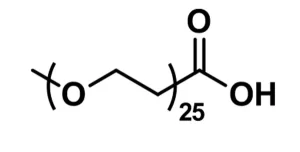Description
m-dPEG®25-amido-dPEG®24-acid, product number QBD-11097, is a long (153 atoms, 179.8 Å), methyl-capped, discrete chain length polyethylene glycol (dPEG®) spacer. The effective length of the dPEG® spacer is about 49 ethylene oxide units (i.e., m-dPEG®49-acid) with an amide bond in the middle of the chain. The reactive end of the molecule terminates in a propionic acid group. The terminal propionic acid moiety can be coupled directly to free amines using EDC or another carbodiimide. Alternatively, converting the reactive end into an active ester permits the conjugation of the transformed product to free amines. N-hydroxysuccinimide (NHS), 2,3,5,6-tetrafluorophenol (TFP), and 2,3,4,5,6-pentafluorophenol (PFP) are typically used for this purpose.
m-dPEG®25-amido-dPEG®24-acid, QBD-11097, reacts with amine-functionalized surfaces (carbon nanotubes, nanoparticles made of silica or various metals, quantum dots, and similar types of products) or free amines on biomolecules. When used to coat surfaces or modify biomolecules, m-dPEG®25-amido-dPEG®24-acid reduces or eliminates non-specific binding and increases water solubility. Crucially, the elimination of non-specific binding may increase the signal-to-noise ratio in imaging applications and assays where this is a consideration. Please note that modifying the surface amines of biomolecules with this uncharged, methyl-capped dPEG® spacer may alter the overall charge of the resulting conjugates.
References
Greg T. Hermanson, Bioconjugate Techniques, 2nd Edition, Elsevier Inc., Burlington, MA 01803, April, 2008 (ISBN-13: 978-0-12-370501-3; ISBN-10: 0-12-370501-0). Specifically see pp. 726-729 in his Chapter 18 on discrete PEG compounds for pegylation applications.
Greg T. Hermanson, Bioconjugate Techniques, 3rd Edition, Elsevier, Waltham, MA 02451, 2013, ISBN 978-0-12-382239-0; See chapter 18, Discrete PEG Reagents, pp.787-821, for a full overview of the dPEG® products.






